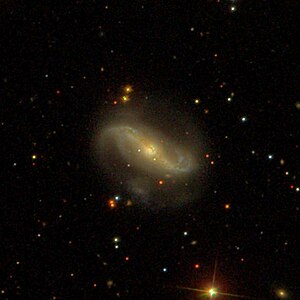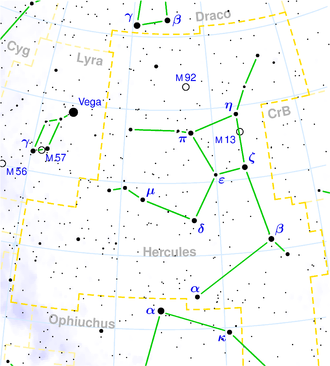NGC 6186
| Galaxy NGC 6186 |
|
|---|---|

|
|
| SDSS recording | |
| AladinLite | |
| Constellation | Hercules |
|
Position equinox : J2000.0 , epoch : J2000.0 |
|
| Right ascension | 16 h 34 m 25.5 s |
| declination | + 21 ° 32 ′ 27 ″ |
| Appearance | |
| Morphological type | (R ') SB (s) a |
| Brightness (visual) | 13.1 mag |
| Brightness (B-band) | 14.0 mag |
| Angular expansion | 1.5 ′ × 1.2 ′ |
| Position angle | 60 ° |
| Surface brightness | 13.6 mag / arcmin² |
| Physical data | |
| Redshift | 0.009797 ± 0.000096 |
| Radial velocity | (2937 ± 29) km / s |
|
Stroke distance v rad / H 0 |
(137 ± 10) x 10 6 ly (41.9 ± 3.0) Mpc |
| history | |
| discovery | Wilhelm Herschel |
| Discovery date | April 28, 1788 |
| Catalog names | |
| NGC 6186 • UGC 10448 • PGC 58523 • CGCG 138-038 • MCG + 04-39-15 • IRAS 16322 + 2138 • 2MASX J16342548 + 2132270 • GC 4222 • H III 730 • LDCE 1193 NED004 | |
NGC 6186 is a 13.1 likes bright barred spiral galaxy of Hubble type SBa in the constellation Hercules. It is estimated to be 134 million light years from the Milky Way and about 60,000 ly in diameter.
The object was discovered on April 28, 1788 by Wilhelm Herschel with an 18.7-inch reflector telescope, who described it as "eF, vS, E".
